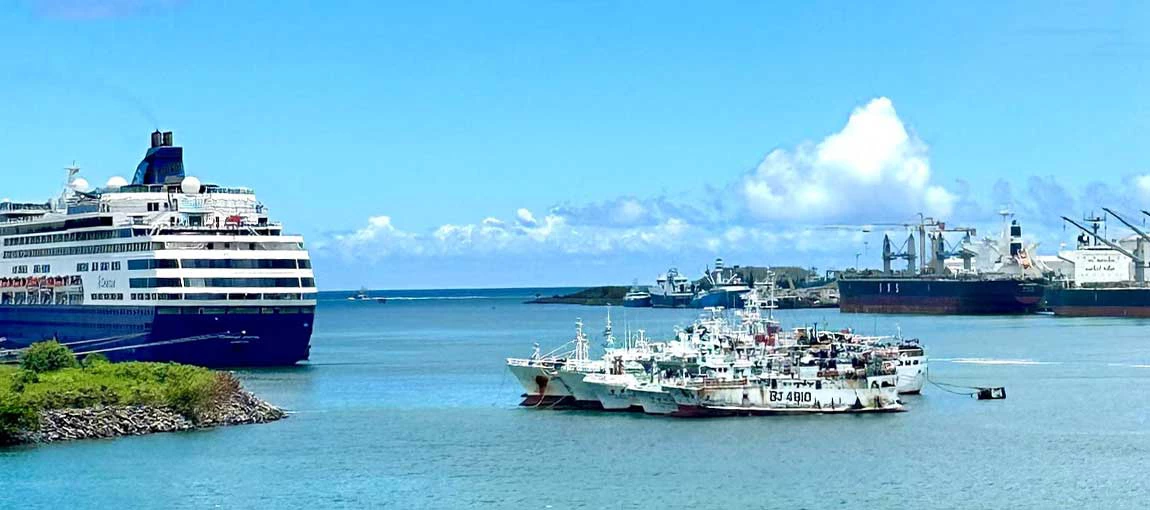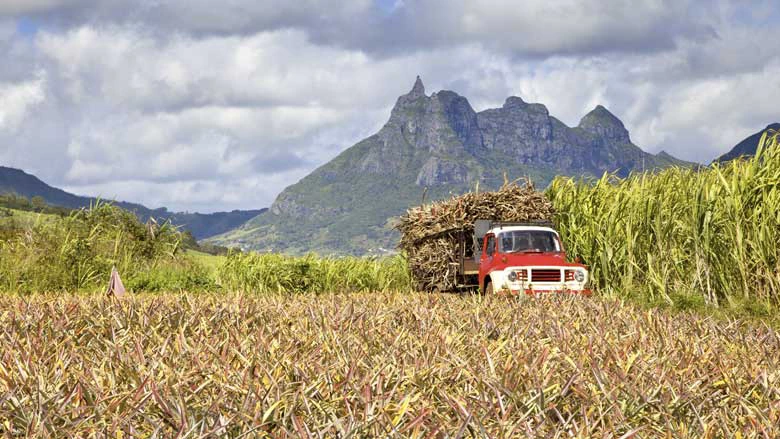 The waterfront of Port Louis, the capital city of Mauritius, showing the tourist side of the island (with the cruise ship) and the harbor area which deals with imports and exports of goods. Photo: Vinaya Swaroop / World Bank
The waterfront of Port Louis, the capital city of Mauritius, showing the tourist side of the island (with the cruise ship) and the harbor area which deals with imports and exports of goods. Photo: Vinaya Swaroop / World Bank
Mauritius’s development story is a fairy tale in Sub-Saharan Africa (SSA). No other country in SSA has managed its economy so successfully: from a sugarcane-based, low-income country with a per capita income of $260 in the 1960s, the island has transformed itself into an upper-middle income country with a per capita income that now exceeds $10,000. Moreover, as an enduring democracy, Mauritius continues to be a regional leader when it comes to political stability, and was ranked first among the 54 African nations in the 2021 Ibrahim Index of African Governance.
Notwithstanding its small size—with a population of 1.3 million in 2023—and remote location—off the eastern coast of the African continent, about 500 miles east of Madagascar in the Indian Ocean—Mauritius stands out as a shining example of successful diversification. From a monocrop agriculture-based economy, it has diversified its production base towards tourism, textile and apparel, and fisheries. Over the past decade, the production base has also gradually expanded to include agriculture value-addition products, financial services, and information technology. More recently, and especially after the COVID-19 pandemic, the government has made it a priority to develop the pharmaceutical industry and to export high-value medical devices as part of its economic diversification agenda. If economic development can be summarized as a process of sustained high economic growth and transformation from low- to higher-productivity activities, Mauritius is among the very few countries in SSA that have successfully embarked on that path.
There are many small and big resource-rich economies in SSA that depend largely on oil and mineral wealth – for example, Angola relies on oil, Botswana on diamonds, the Democratic Republic of Congo on minerals, Seychelles on tourism, and Zambia on copper. These countries have so far been unable to achieve successful and sustained diversification. Can the lessons from Mauritius show them the path to implementing successful development strategies based on diversification and structural transformation? Are there other complementary factors (e.g., human capital enhancement) that they should consider to achieve these objectives?

Mauritius’s diversification journey. After Mauritius’ independence from Great Britain in 1968, the country’s agriculture sector was dominated by sugar cane production, a colonial legacy that accounted for about 22% of GDP in the late 1960s. Instead of embarking on agricultural land redistribution, Mauritius found a consensus to leverage taxes collected from sugar production, which benefited from the EU import quota, for investing in human capital and social programs. Net primary school enrollment in Mauritius reached 96% in 2007 (compared to 74% for SSA). Instead of adopting an import-substitution industrial policy, Mauritius used the proceeds from sugar exports to develop infrastructure and build export-processing facilities capable of supporting the export-oriented industrial development strategy (which included textiles, garments, and canned fishery). Manufacturing exports reached their peak in 2000 and comprised 80% of total merchandise exports that year, compared to 11% in 1975. Mauritius’ continued openness to foreign investments contributed to growth of its financial services with a growing global footprint.
These achievements reflect Mauritius’s quest for higher economic growth. Macroeconomic and political stability helped the private sector to focus on their business by implementing their investment plans. A strong public-private dialogue between the private sector and authorities helps underpin reforms that have made it easier to attract more investments, including new ones in information and communication technologies (ICT) and niche manufacturing. The Mauritian authorities have made continuous efforts to improve transparency in their regulations and their alignment with international practices. A few recent examples include the proactive decisions taken to avoid being put on a grey list in global financial markets, and the pragmatic policies which have been introduced to help firms access foreign talents when skill shortages hit.
Recovery from the devastating COVID-19 shock. Thanks to its strong and diversified growth, Mauritius became a high-income country in 2020. However, the devastating impact of COVID-19 on the tourism sector reversed this progress and pushed the country back into the upper-middle income bracket. With a stringent lockdown imposed from March to May 2020, and closure of international travels until October 2020, the Mauritian economy contracted by 14.6% in 2020 – a decline more than the average rate for all other countries. To save lives and livelihoods, the government deployed a large state support program which, in combination with lockdown and quarantine measures, was successful in controlling the public health emergency and protecting livelihoods. But the government support program came at a high fiscal cost. Public debt spiked and huge transfers were made by the Bank of Mauritius to the Government. The central bank’s involvement in fiscal policy, both directly and indirectly through the Mauritius Investment Company (MIC), opened a channel of liquidity which supported large and systemic firms. While the creation of MIC has raised controversy in some quarters, others have justified it as an extraordinary measure taken to manage an extraordinary situation.
As the country recovers from the COVID setback, the government sees an opportunity to continue to implement reforms to boost growth and reinforce resilience in the post-COVID period. The country’s ability to address emerging constraints as it keeps chugging along the development path puts it among the select group of countries which continue to perform well and improve the welfare of its citizens. The reforms that the government has taken or is contemplating taking include:
- Plans and actions to address emerging labor market constraints. To facilitate higher women’s participation in the workplace, childcare centers are being set up under public-private partnerships, and corporate tax deductions are being provided to companies to offset the cost of running them. To improve access to skilled workers and respond to labor shortages, more foreign workers are being allowed in, and occupation permits are being extended for those who are already in the country and working.
- Mauritius was placed on the “Jurisdictions under Increased Monitoring” grey list in 2020 by the Financial Action Task Force (FATF). Responding to the charge, the country has prepared a National Risk Assessment (NRA) report. A plan of actions designed to deal with identified risks related to money laundering and terrorist financing is also being prepared and will likely be codified into new legislation.
- Water requirements are high for agriculture (they still grow sugarcane!) and the tourism sector, and climate change will increase the risk of water stress. Large losses in revenue are constraining the ability to maintain and expand water services to other places like Rodrigues Island. A new legislation will improve sustainability of water usage, improve efficiency in water services, and promote the use of wastewater.
- Mauritius currently relies heavily on coal and heavy fuels for power generation and the government wants to have renewable energy sources account for 60% of the country’s electricity consumption by 2030. However, developing renewable energy capacities will require a large amount of private investment since, as the government knows, the public utility company cannot foot such a bill. To achieve this, policies are being contemplated to improve the investment environment in the renewable energy sector and clarity in sourcing from renewables, including the byproducts from sugar production.
The sight of Mauritius’s Airport Duty-free shops selling attractive packages of various condiments and seasonings is a sign that this SSA country has been successfully producing and marketing high-end agriculture value-addition products. Economic diversification in SSA countries has been a mantra frequently promoted as a development objective; but sadly, there is not much progress to show.
While Mauritius, like all developing and emerging economies, is still facing its own set of challenges to further improve its economy, it can certainly offer a lesson or two on how to achieve successful and sustained diversification.



Join the Conversation